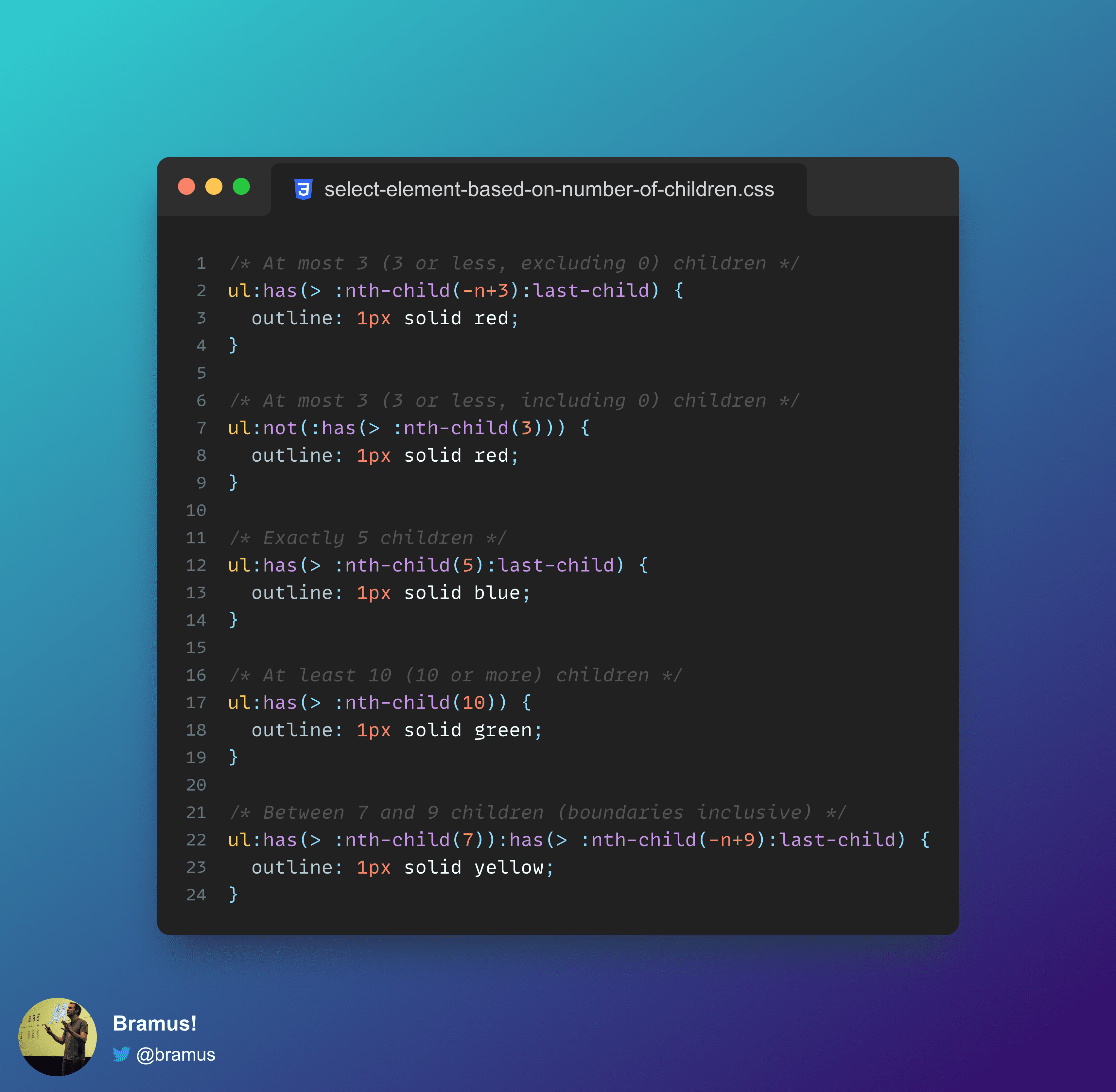This content originally appeared on Bram.us and was authored by Bramus!
In CSS it’s possible to style elements based on the number of siblings they have by leveraging the nth-child selector.
But what if you want to style the parent element based on the number of children? Well, that where the CSS :has() selector comes into play.
~
# The code
If you’re just here for the code, here it is. You can also see it in action in the demo below.
/* At most 3 (3 or less, excluding 0) children */
ul:has(> :nth-child(-n+3):last-child) {
outline: 1px solid red;
}
/* At most 3 (3 or less, including 0) children */
ul:not(:has(> :nth-child(3))) {
outline: 1px solid red;
}
/* Exactly 5 children */
ul:has(> :nth-child(5):last-child) {
outline: 1px solid blue;
}
/* At least 10 (10 or more) children */
ul:has(> :nth-child(10)) {
outline: 1px solid green;
}
/* Between 7 and 9 children (boundaries inclusive) */
ul:has(> :nth-child(7)):has(> :nth-child(-n+9):last-child) {
outline: 1px solid yellow;
}If you want to know how it works, keep on reading 🙂
~
# The selectors
The pattern of each selector built here is this:
parent:has(> count-condition) {
…
}- By using
parent:has()we can select theparentelement that meets a certain condition for its children. - By passing
>into:has(), we target theparent’s direct children. - The
count-conditionis something we need to come up with for each type of selection we want to do. Similar to Quantity Queries, we’ll leverage:nth-child()for this.
☝️ Although the :has() selector is often called the parent selector, it is way more than that.
At most x children
By using :nth-child with a negative -n it’s possible to select the first x children. If one of those is also the very last child, you can detect if a parent has up to x children
/* At most 3 (3 or less, excluding 0) children */
ul:has(> :nth-child(-n+3):last-child) {
outline: 1px solid red;
}This selector excludes parents that have no children. This is fine in most cases – as any element that only contains text would be matched – but if you do want to include use this selector instead:
/* At most 3 (3 or less, including 0) children */
ul:not(:has(> :nth-child(3))) {
outline: 1px solid red;
}Exactly x children
To select item x from a set you can use :nth-child without any n indication. If that child is also the last child, you know there’s exactly x children in the parent
/* Exactly 5 children */
ul:has(> :nth-child(5):last-child) {
outline: 1px solid blue;
}At least x children
To select a parent with a least x children, being able to select child x in it is enough to determine that. No need for :last-child here.
/* At least 10 (10 or more) children */
ul:has(> :nth-child(10)) {
outline: 1px solid green;
}Between x and y children
To do a between selection, you can combine two :has() conditions together. The first one selects all elements that have x or more children, whereas the second one cuts off the range by only allowing elements that have no more than y children. Only elements that match both conditions will be mathed:
/* Between 7 and 9 children (boundaries inclusive) */
ul:has(> :nth-child(7)):has(> :nth-child(-n+9):last-child) {
outline: 1px solid yellow;
}~
# Demo
See the Pen Styling parent elements based on the number of children with CSS :has() by Bramus (@bramus) on CodePen.
~
# Browser Support
These selectors are supported by all browsers that have :has() support. At the time of writing this does not include Firefox.
Flipping on the experimental :has() support in Firefox doesn’t do the trick either. Its implementation is still experimental as it doesn’t support all types of selection yet. Relative Selector Parsing (i.e. a:has(> b)) is one of those features that’s not supported yet – Tracking bug: #1774588
~
# Spread the word
To help spread the contents of this post, feel free to retweet its announcement tweet:
Style a parent element based on its number of children using CSS `:has()`
🏷 #css #selectors pic.twitter.com/ZMtm4IUD0P
— Bram.us (@bramusblog) November 17, 2022
~
🔥 Like what you see? Want to stay in the loop? Here's how:
This content originally appeared on Bram.us and was authored by Bramus!
Bramus! | Sciencx (2022-11-17T16:27:19+00:00) Style a parent element based on its number of children using CSS :has(). Retrieved from https://www.scien.cx/2022/11/17/style-a-parent-element-based-on-its-number-of-children-using-css-has/
Please log in to upload a file.
There are no updates yet.
Click the Upload button above to add an update.

